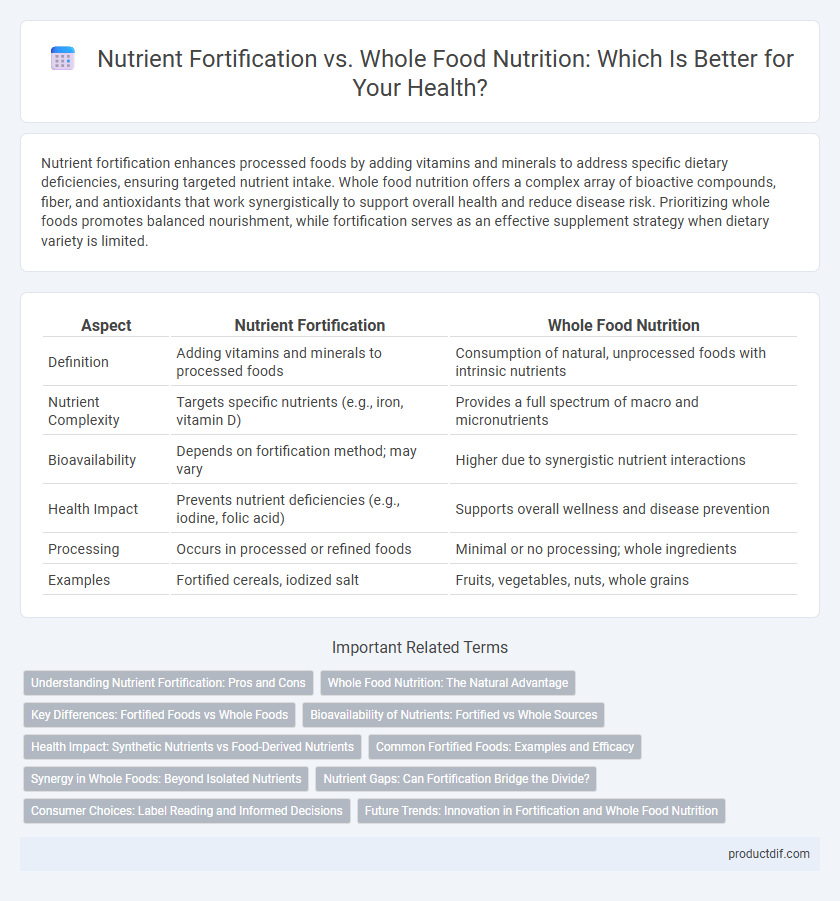Nutrient fortification enhances processed foods by adding vitamins and minerals to address specific dietary deficiencies, ensuring targeted nutrient intake. Whole food nutrition offers a complex array of bioactive compounds, fiber, and antioxidants that work synergistically to support overall health and reduce disease risk. Prioritizing whole foods promotes balanced nourishment, while fortification serves as an effective supplement strategy when dietary variety is limited.
Table of Comparison
| Aspect | Nutrient Fortification | Whole Food Nutrition |
|---|---|---|
| Definition | Adding vitamins and minerals to processed foods | Consumption of natural, unprocessed foods with intrinsic nutrients |
| Nutrient Complexity | Targets specific nutrients (e.g., iron, vitamin D) | Provides a full spectrum of macro and micronutrients |
| Bioavailability | Depends on fortification method; may vary | Higher due to synergistic nutrient interactions |
| Health Impact | Prevents nutrient deficiencies (e.g., iodine, folic acid) | Supports overall wellness and disease prevention |
| Processing | Occurs in processed or refined foods | Minimal or no processing; whole ingredients |
| Examples | Fortified cereals, iodized salt | Fruits, vegetables, nuts, whole grains |
Understanding Nutrient Fortification: Pros and Cons
Nutrient fortification enhances food products by adding essential vitamins and minerals to address dietary deficiencies in populations. While fortification improves nutrient intake and helps prevent diseases like rickets and anemia, it may lead to imbalanced nutrition if whole food diversity is neglected. Relying solely on fortified foods risks missing synergistic benefits of naturally occurring phytochemicals, fiber, and antioxidants found in whole food nutrition.
Whole Food Nutrition: The Natural Advantage
Whole food nutrition offers a natural advantage by providing a complex matrix of vitamins, minerals, fiber, and phytochemicals that work synergistically to enhance absorption and promote overall health. Nutrient fortification often isolates specific nutrients, which may lack the bioavailability and complementary compounds found in whole foods such as fruits, vegetables, grains, and legumes. Emphasizing whole food nutrition supports sustained energy, improved digestion, and a balanced intake of essential nutrients critical for disease prevention and optimal wellness.
Key Differences: Fortified Foods vs Whole Foods
Fortified foods are products enhanced with added vitamins and minerals to address specific nutrient deficiencies, often lacking the complex fiber and antioxidants found in whole foods. Whole foods provide a synergistic combination of natural nutrients, including phytonutrients, fiber, and enzymes, promoting better absorption and overall health benefits. The key difference lies in nutrient bioavailability and complexity, where whole foods support holistic nutrition, while fortified foods target isolated nutrient supplementation.
Bioavailability of Nutrients: Fortified vs Whole Sources
Nutrient fortification enhances foods with specific vitamins and minerals to address deficiencies but may not always match the bioavailability found in whole food nutrition. Whole foods provide a complex matrix of nutrients, fiber, and phytochemicals that improve absorption and utilization of key nutrients such as iron, calcium, and vitamin D. Research shows that the synergistic effects in whole foods optimize nutrient bioavailability more effectively than isolated fortificants.
Health Impact: Synthetic Nutrients vs Food-Derived Nutrients
Synthetic nutrient fortification provides targeted vitamins and minerals that can quickly address deficiencies but may lack the complex bioactive compounds found in whole foods. Whole food nutrition delivers a synergistic blend of nutrients, fiber, and antioxidants that support long-term health and reduce chronic disease risk. Studies show that food-derived nutrients promote better absorption and have more favorable effects on metabolic processes compared to isolated synthetic supplements.
Common Fortified Foods: Examples and Efficacy
Common fortified foods include cereals enriched with iron, milk fortified with vitamin D, and salt iodized with iodine, each targeting specific nutrient deficiencies. Fortification effectively addresses public health concerns, such as reducing anemia through iron-enriched cereals or preventing rickets with vitamin-D-fortified milk. However, whole food nutrition provides a complex mix of vitamins, minerals, fiber, and bioactive compounds that work synergistically beyond isolated added nutrients.
Synergy in Whole Foods: Beyond Isolated Nutrients
Whole foods provide a complex matrix of vitamins, minerals, fiber, and phytochemicals that work synergistically to enhance nutrient absorption and effectiveness, unlike isolated nutrient fortification which may lack these interactions. Synergy in whole food nutrition supports improved immune function, antioxidant activity, and metabolic health by preserving the natural balance of compounds. Research shows that consuming nutrients in their whole food form leads to better long-term health outcomes compared to reliance on fortified products or supplements.
Nutrient Gaps: Can Fortification Bridge the Divide?
Nutrient fortification targets specific deficiencies by adding vitamins and minerals to commonly consumed foods, effectively addressing nutrient gaps in large populations. Whole food nutrition offers a complex matrix of bioavailable nutrients and phytochemicals that work synergistically, supporting overall health beyond isolated nutrient intake. While fortification can alleviate certain deficiencies rapidly, it cannot entirely replace the comprehensive benefits of whole foods in long-term nutritional strategies.
Consumer Choices: Label Reading and Informed Decisions
Consumers weighing nutrient fortification against whole food nutrition should prioritize detailed label reading to make informed decisions about dietary intake. Understanding the presence and quantity of added vitamins and minerals versus natural nutrient content guides healthier choices aligned with individual health goals. Transparency in labeling supports consumers in selecting products that meet their nutritional needs without relying solely on supplementation.
Future Trends: Innovation in Fortification and Whole Food Nutrition
Emerging trends in nutrient fortification emphasize bioavailability enhancements through nanotechnology and precision fortification tailored to individual dietary needs. Whole food nutrition innovations leverage advanced breeding techniques and sustainable agriculture to increase inherent nutrient density and phytochemical content. Integration of AI-driven nutritional profiling supports personalized consumption patterns, blending fortified products with natural whole foods to optimize health outcomes.
Nutrient Fortification vs Whole Food Nutrition Infographic

 productdif.com
productdif.com